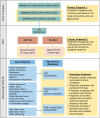Feasibility pilot trial for the Trajectories of Recovery after Intravenous propofol versus inhaled VolatilE anesthesia (THRIVE) pragmatic randomised controlled trial
- PMID: 37068889
- PMCID: PMC10111921
- DOI: 10.1136/bmjopen-2022-070096
Feasibility pilot trial for the Trajectories of Recovery after Intravenous propofol versus inhaled VolatilE anesthesia (THRIVE) pragmatic randomised controlled trial
Abstract
Introduction: Millions of patients receive general anaesthesia for surgery annually. Crucial gaps in evidence exist regarding which technique, propofol total intravenous anaesthesia (TIVA) or inhaled volatile anaesthesia (INVA), yields superior patient experience, safety and outcomes. The aim of this pilot study is to assess the feasibility of conducting a large comparative effectiveness trial assessing patient experiences and outcomes after receiving propofol TIVA or INVA.
Methods and analysis: This protocol was cocreated by a diverse team, including patient partners with personal experience of TIVA or INVA. The design is a 300-patient, two-centre, randomised, feasibility pilot trial. Patients 18 years of age or older, undergoing elective non-cardiac surgery requiring general anaesthesia with a tracheal tube or laryngeal mask airway will be eligible. Patients will be randomised 1:1 to propofol TIVA or INVA, stratified by centre and procedural complexity. The feasibility endpoints include: (1) proportion of patients approached who agree to participate; (2) proportion of patients who receive their assigned randomised treatment; (3) completeness of outcomes data collection and (4) feasibility of data management procedures. Proportions and 95% CIs will be calculated to assess whether prespecified thresholds are met for the feasibility parameters. If the lower bounds of the 95% CI are above the thresholds of 10% for the proportion of patients agreeing to participate among those approached and 80% for compliance with treatment allocation for each randomised treatment group, this will suggest that our planned pragmatic 12 500-patient comparative effectiveness trial can likely be conducted successfully. Other feasibility outcomes and adverse events will be described.
Ethics and dissemination: This study is approved by the ethics board at Washington University (IRB# 202205053), serving as the single Institutional Review Board for both participating sites. Recruitment began in September 2022. Dissemination plans include presentations at scientific conferences, scientific publications, internet-based educational materials and mass media.
Trial registration number: NCT05346588.
Keywords: general anesthesia; inhaled volatile anesthesia; total intravenous anesthesia.
© Author(s) (or their employer(s)) 2023. Re-use permitted under CC BY-NC. No commercial re-use. See rights and permissions. Published by BMJ.
Conflict of interest statement
Competing interests: None declared.
Figures

References
-
- Elbakry A-E, Sultan W-E, Ibrahim E. A comparison between inhalational (desflurane) and total intravenous anaesthesia (propofol and dexmedetomidine) in improving postoperative recovery for morbidly obese patients undergoing laparoscopic sleeve gastrectomy: a double-blinded randomised controlled trial. J Clin Anesth 2018;45:6–11. 10.1016/j.jclinane.2017.12.001 - DOI - PubMed
Publication types
MeSH terms
Substances
Associated data
Grants and funding
LinkOut - more resources
Full Text Sources
Medical
Miscellaneous
